Items
-
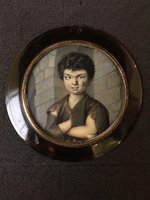 Portrait miniature of a ragged boy Portrait miniature on ivory of a ragged boy. The boy's clothing is torn and he poses with his arms crossed. Painted in England by Irish artist Peter Paul Lens, this miniature is unique in its sitter and depiction, and is an example of the variety of portrait miniatures.
Portrait miniature of a ragged boy Portrait miniature on ivory of a ragged boy. The boy's clothing is torn and he poses with his arms crossed. Painted in England by Irish artist Peter Paul Lens, this miniature is unique in its sitter and depiction, and is an example of the variety of portrait miniatures. -
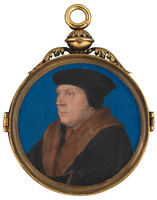 Thomas Cromwell, Earl of Essex This portrait of Thomas Cromwell may be one of the first miniatures Holbein painted. Cromwell is pictured in profile, wearing a brown coat and hat. It was made during his second visit to England in 1532 when Cromwell was advancing as a trusted councillor of the king. The mount has been cut from a playing card of the suit of spades. This portrait is mounted in the same case as another, later, miniature of Cromwell.
Thomas Cromwell, Earl of Essex This portrait of Thomas Cromwell may be one of the first miniatures Holbein painted. Cromwell is pictured in profile, wearing a brown coat and hat. It was made during his second visit to England in 1532 when Cromwell was advancing as a trusted councillor of the king. The mount has been cut from a playing card of the suit of spades. This portrait is mounted in the same case as another, later, miniature of Cromwell. -
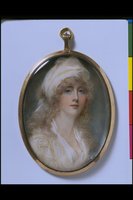 Anne Mee, Self Portrait Miniature self portrait by Mrs. Anne Mee, born Anne Foldsone, on ivory. Great Britain, ca.1795. Oval head and shoulders miniature portrait, turned slightly to right and looking to front. The sitter is wearing a cream dress, her hair about her shoulders and fabric around her head. In the 18th century, miniature painting was a popular genteel pastime, particularly for ladies. Miniature painting could therefore offer those gentlewomen who found themselves with neither father nor husband to support them the chance to earn a living from their former pastime. This is a self-portrait by Anna Foldsone, who lost her father when young and took to miniature painting to support her mother and her many siblings. When she married, becoming generally known as ‘Mrs Mee’, she continued to paint. But the diarist Joseph Farington noted that Mrs Mee's husband ‘had consented to let her paint ladies only who were never to be attended [at the sittings] by gentlemen’. The reason for this was that painting a portrait was an intimate process, with the artist looking intently at a sitter at close quarters. This is precisely the intimacy that made it so attractive as a domestic art for ladies painting their close relations and friends. But in a professional studio, such a closeness could lead to gossip concerning impropriety. Hence, many women miniaturists chose (or were persuaded) not to work professionally after marriage. In contrast, Mrs Mee continued as a highly successful artist, most famously working at Windsor Castle on a series of paintings of ‘beauties’ - portraits of the most glamorous women attached to the Court.
Anne Mee, Self Portrait Miniature self portrait by Mrs. Anne Mee, born Anne Foldsone, on ivory. Great Britain, ca.1795. Oval head and shoulders miniature portrait, turned slightly to right and looking to front. The sitter is wearing a cream dress, her hair about her shoulders and fabric around her head. In the 18th century, miniature painting was a popular genteel pastime, particularly for ladies. Miniature painting could therefore offer those gentlewomen who found themselves with neither father nor husband to support them the chance to earn a living from their former pastime. This is a self-portrait by Anna Foldsone, who lost her father when young and took to miniature painting to support her mother and her many siblings. When she married, becoming generally known as ‘Mrs Mee’, she continued to paint. But the diarist Joseph Farington noted that Mrs Mee's husband ‘had consented to let her paint ladies only who were never to be attended [at the sittings] by gentlemen’. The reason for this was that painting a portrait was an intimate process, with the artist looking intently at a sitter at close quarters. This is precisely the intimacy that made it so attractive as a domestic art for ladies painting their close relations and friends. But in a professional studio, such a closeness could lead to gossip concerning impropriety. Hence, many women miniaturists chose (or were persuaded) not to work professionally after marriage. In contrast, Mrs Mee continued as a highly successful artist, most famously working at Windsor Castle on a series of paintings of ‘beauties’ - portraits of the most glamorous women attached to the Court. -
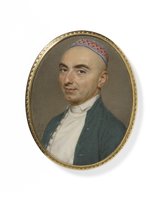 Portrait of Edward Raphael (d.1791) Portrait miniature, Portrait of Edward Raphael (d.1791) by John Smart, British School, India, 1789. Portrait miniature of a gentleman wearing an embroidered topi hat, white shirt and green Bandhgala jacket.
Portrait of Edward Raphael (d.1791) Portrait miniature, Portrait of Edward Raphael (d.1791) by John Smart, British School, India, 1789. Portrait miniature of a gentleman wearing an embroidered topi hat, white shirt and green Bandhgala jacket. -
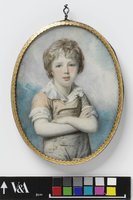 Unknown boy, perhaps Sir Frederick Augustus D'Este (1794-1848) Portrait miniature of an unknown boy, perhaps Sir Frederick Augustus D'Este, dated 1799, painted on ivory by Richard Cosway (1742-1821). Portrait of a boy with his sleeves pushed up and his arms crossed, standing against a sky background. He is dressed in a so-called "skeleton suit".
Unknown boy, perhaps Sir Frederick Augustus D'Este (1794-1848) Portrait miniature of an unknown boy, perhaps Sir Frederick Augustus D'Este, dated 1799, painted on ivory by Richard Cosway (1742-1821). Portrait of a boy with his sleeves pushed up and his arms crossed, standing against a sky background. He is dressed in a so-called "skeleton suit". -
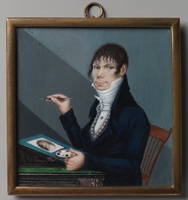 Self Portrait In this bold self-portrait, a miniature painter depicts himself with the tools of his trade, including paint brushes and an oval ivory palette with watercolor pigments (similar to those on display nearby). Seated in a colonial side chair and fashionably dressed in an embroidered blue waistcoat, he pauses from painting a miniature portrait of a young woman to meet the viewer’s gaze. Although the artist’s identity remains unknown, he is believed to have been biracial and likely worked in or around New Orleans, Louisiana, where this self-portrait was discovered.
Self Portrait In this bold self-portrait, a miniature painter depicts himself with the tools of his trade, including paint brushes and an oval ivory palette with watercolor pigments (similar to those on display nearby). Seated in a colonial side chair and fashionably dressed in an embroidered blue waistcoat, he pauses from painting a miniature portrait of a young woman to meet the viewer’s gaze. Although the artist’s identity remains unknown, he is believed to have been biracial and likely worked in or around New Orleans, Louisiana, where this self-portrait was discovered. -
 Mary Walpole (née Lombard), Lady Walpole of Wolterton Mary Walpole (née Lombard), Lady Walpole of Wolterton (1694 or 1695-1783), Wife of 1st Baron Walpole of Wolterton. She wears a blue and white dress with a pink overlay. Her gaze is direct though her face is slightly turned, and she has a small, slightly knowing smile. The blue of her eyes and pink in her complexion are saturated in tone and reminiscent of the colors of her clothing.
Mary Walpole (née Lombard), Lady Walpole of Wolterton Mary Walpole (née Lombard), Lady Walpole of Wolterton (1694 or 1695-1783), Wife of 1st Baron Walpole of Wolterton. She wears a blue and white dress with a pink overlay. Her gaze is direct though her face is slightly turned, and she has a small, slightly knowing smile. The blue of her eyes and pink in her complexion are saturated in tone and reminiscent of the colors of her clothing. -
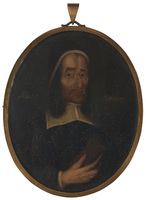 Richard Baxter Richard Baxter is pictured in semi-profile. He wears the traditional clothing of a 17th century Protestant faith leader. The depiction of Baxter holding a Bible also implied his religious commitment and status with British Protestantism.
Richard Baxter Richard Baxter is pictured in semi-profile. He wears the traditional clothing of a 17th century Protestant faith leader. The depiction of Baxter holding a Bible also implied his religious commitment and status with British Protestantism. -
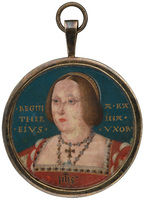 Katherine of Aragon Portrait of Katherine of Aragon wearing a red dress with white embroidery and gold headpiece. The background is green with a gold inscription in Latin. The Latin inscription signifies 'Katherine, his wife', and suggests that this miniature was a pair with one of Henry VIII. She wears a jeweled cross and a brooch with the letters IHS, the first three letters of the name of Jesus in Greek.
Katherine of Aragon Portrait of Katherine of Aragon wearing a red dress with white embroidery and gold headpiece. The background is green with a gold inscription in Latin. The Latin inscription signifies 'Katherine, his wife', and suggests that this miniature was a pair with one of Henry VIII. She wears a jeweled cross and a brooch with the letters IHS, the first three letters of the name of Jesus in Greek. -
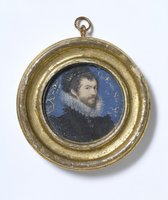 Nicholas Hilliard, Self-portrait, aged 30 Miniature self-portrait of Nicholas Hilliard, watercolor on vellum, 1577. Portrait of a young man, head and shoulders, turned slightly to right and looking to front; the sitter is wearing a black cap and a ruff; inscriptions in gold on either side of the portrait on a blue background. The painting set in a gold circular frame with raised concentric circles.
Nicholas Hilliard, Self-portrait, aged 30 Miniature self-portrait of Nicholas Hilliard, watercolor on vellum, 1577. Portrait of a young man, head and shoulders, turned slightly to right and looking to front; the sitter is wearing a black cap and a ruff; inscriptions in gold on either side of the portrait on a blue background. The painting set in a gold circular frame with raised concentric circles. -
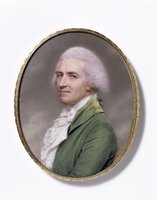 Miniature self-portrait of John Smart Miniature self portrait on ivory by John Smart, British, 1797 Miniature self portrait on ivory depicting the artist in a green coat with his body in profile and face turned slightly towards the viewer.
Miniature self-portrait of John Smart Miniature self portrait on ivory by John Smart, British, 1797 Miniature self portrait on ivory depicting the artist in a green coat with his body in profile and face turned slightly towards the viewer. -
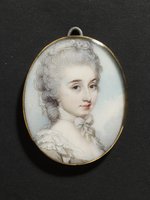 Selina Innes Portrait miniature of a young woman. Portrait of miniature of Selina Innes, daughter of Sir William Chambers (RA) and wife of William Innes, painted by George Englehardt, late 18th century.
Selina Innes Portrait miniature of a young woman. Portrait of miniature of Selina Innes, daughter of Sir William Chambers (RA) and wife of William Innes, painted by George Englehardt, late 18th century. -
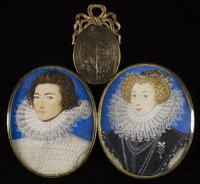 John Croker of Barton, Oxfordshire, and his wife Frances, whom he married in 1581 Two miniature portraits, set in one frame, of John Croker and his wife Frances (nee Kingsmill). The portrait of Frances Croker seems to relate to a portrait of her attributed to George Gower, oil on panel, W.1-1931. These miniatures were re-attributed around 1975 as 'style of Nicholas Hilliard, 19th century'. They have now been re-catalogued as 16th century, by Nicholas Hilliard, watercolour on vellum, 16th century, English School
John Croker of Barton, Oxfordshire, and his wife Frances, whom he married in 1581 Two miniature portraits, set in one frame, of John Croker and his wife Frances (nee Kingsmill). The portrait of Frances Croker seems to relate to a portrait of her attributed to George Gower, oil on panel, W.1-1931. These miniatures were re-attributed around 1975 as 'style of Nicholas Hilliard, 19th century'. They have now been re-catalogued as 16th century, by Nicholas Hilliard, watercolour on vellum, 16th century, English School -
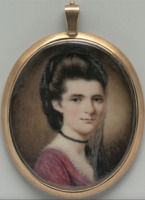 Elizabeth Ann Timothy The miniature is thought to have been an engagement gift from the sitter to her fiancé, William Williamson. They were married in 1785. Elizabeth Ann Timothy was born in 1746 in Charleston, the daughter of Peter and Anna Timothy. Her first husband was Peter Valton. The portrait is of the sitter in profile, with her face turned forward and smiling. She has brown hair decorated with a veil, and is wearing a pink dress and black necklace.
Elizabeth Ann Timothy The miniature is thought to have been an engagement gift from the sitter to her fiancé, William Williamson. They were married in 1785. Elizabeth Ann Timothy was born in 1746 in Charleston, the daughter of Peter and Anna Timothy. Her first husband was Peter Valton. The portrait is of the sitter in profile, with her face turned forward and smiling. She has brown hair decorated with a veil, and is wearing a pink dress and black necklace. -
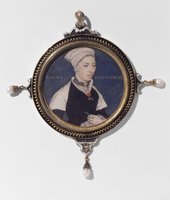 Mrs Jane Small, formerly Mrs Pemberton Portrait miniature of Mrs Jane Small, formerly Mrs Pemberton, watercolour on vellum in a decorated case, by Hans Holbein, ca. 1536. Portrait miniature of a woman, half-length, turned to right, contained in a circular case, the lid decorated with a dragon and other heraldic devices. Unique in that this portrait miniature depicts someone other than a courtier, the identity of the woman painted by Holbein is likely Mrs. Jane Small, nee Pemberton. Jane was married to a prosperous London merchant, Nicholas Small. She and her husband were neighbors of Holbein's. It is unknown if Holbein painted this portrait for a particular occasion, or why the sitter is shown holding a leaf and wearing a red flower and two ears of corn.
Mrs Jane Small, formerly Mrs Pemberton Portrait miniature of Mrs Jane Small, formerly Mrs Pemberton, watercolour on vellum in a decorated case, by Hans Holbein, ca. 1536. Portrait miniature of a woman, half-length, turned to right, contained in a circular case, the lid decorated with a dragon and other heraldic devices. Unique in that this portrait miniature depicts someone other than a courtier, the identity of the woman painted by Holbein is likely Mrs. Jane Small, nee Pemberton. Jane was married to a prosperous London merchant, Nicholas Small. She and her husband were neighbors of Holbein's. It is unknown if Holbein painted this portrait for a particular occasion, or why the sitter is shown holding a leaf and wearing a red flower and two ears of corn. -
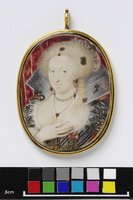 Portrait of Anne of Denmark, Queen of James I Portrait miniature of Anne of Denmark, Queen of James I, ca. 1612, watercolour on vellum, painted by Isaac Oliver (ca. 1560-1617). James Stuart married Anne of Denmark in 1589 when he was James VI of Scotland. She produced two male heirs, Prince Henry and Prince Charles, and a daughter, Princes Elizabeth.
Portrait of Anne of Denmark, Queen of James I Portrait miniature of Anne of Denmark, Queen of James I, ca. 1612, watercolour on vellum, painted by Isaac Oliver (ca. 1560-1617). James Stuart married Anne of Denmark in 1589 when he was James VI of Scotland. She produced two male heirs, Prince Henry and Prince Charles, and a daughter, Princes Elizabeth. -
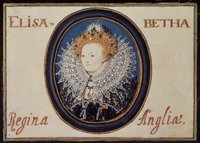 Portrait of Queen Elizabeth I Portrait of Elizabeth I, half length, in an oval within a rectangular frame. On either side of the portrait are inscriptions in gold. Portrait of a woman, half length, looking to left and wearing an elaborate ruff and dress; her hair and costume are adorned with jewels.
Portrait of Queen Elizabeth I Portrait of Elizabeth I, half length, in an oval within a rectangular frame. On either side of the portrait are inscriptions in gold. Portrait of a woman, half length, looking to left and wearing an elaborate ruff and dress; her hair and costume are adorned with jewels. -
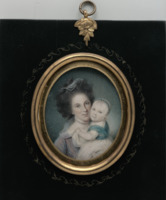 Mrs. Charles Willson Peale (Rachel Brewer) and Baby Eleanor Portrait miniature of the artist's wife and infant daughter, Eleanor. Mrs. Peale is dressed in a mauve gown, hat, and double strand pearl necklace. Eleanor is dressed in a blue and white baby gown, with matching blue headband. Both have their faces pressed together and are looking forward and smiling. Peale painted this portrait of his first wife just after her death in 1790.
Mrs. Charles Willson Peale (Rachel Brewer) and Baby Eleanor Portrait miniature of the artist's wife and infant daughter, Eleanor. Mrs. Peale is dressed in a mauve gown, hat, and double strand pearl necklace. Eleanor is dressed in a blue and white baby gown, with matching blue headband. Both have their faces pressed together and are looking forward and smiling. Peale painted this portrait of his first wife just after her death in 1790. -
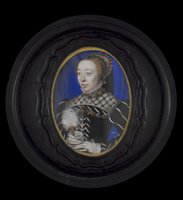 Catherine de Medici Portrait of Catherine de Medici in an oval frame, half-length, holding a fan. Portrait of a woman, half-length, turned slightly to left, wearing a ruff and jewelled headdress and holding a fan in her right hand; the other hand is resting on the gold border surrounding the portrait.
Catherine de Medici Portrait of Catherine de Medici in an oval frame, half-length, holding a fan. Portrait of a woman, half-length, turned slightly to left, wearing a ruff and jewelled headdress and holding a fan in her right hand; the other hand is resting on the gold border surrounding the portrait. -
 Portrait miniature of Anne of Cleves (1515-1557), set in a turned ivory box Portrait miniature of Anne of Cleves by Hans Holbein the younger (1497-1543). Set in a circular turned ivory box by an unknown maker, Britain or perhaps Germany. Portrait miniature of a woman, full face, head and shoulders, to front, in a circular box with a lid, into which is carved in the form of petals, a Tudor rose.
Portrait miniature of Anne of Cleves (1515-1557), set in a turned ivory box Portrait miniature of Anne of Cleves by Hans Holbein the younger (1497-1543). Set in a circular turned ivory box by an unknown maker, Britain or perhaps Germany. Portrait miniature of a woman, full face, head and shoulders, to front, in a circular box with a lid, into which is carved in the form of petals, a Tudor rose.